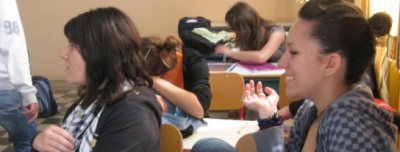Pupils at Pentapolis High School in Serres, Greece, share their views on the Rosetta Stone.
 The stone is one of the most famous objects in the British Museum. The inscription relates to 13-year-old Ptolemy V's coronation in 196 BC. The same inscription is written in Greek, hieroglyphs and demotic Egyptian. It was this Greek inscription that allowed modern scholars to decipher hieroglyphs for the first time.
The stone is one of the most famous objects in the British Museum. The inscription relates to 13-year-old Ptolemy V's coronation in 196 BC. The same inscription is written in Greek, hieroglyphs and demotic Egyptian. It was this Greek inscription that allowed modern scholars to decipher hieroglyphs for the first time.
Do you know the story behind the acquisition of the Rosetta Stone and the Parthenon Sculptures by the British Museum?

“Many years ago, when Napoleon Bonaparte conquered Egypt, the Rosetta Stone was discovered by French soldiers in the Nile Delta town of el-Rashid, or Rosetta. On Napoleon’s defeat in 1801, the artefact was taken by British troops and shipped to London. It has been on display in the museum in London since 1802. When Greece was ruled by the Ottomans, Elgin was given permission to remove the marbles lying on the Parthenon floor. He took many pieces from the Acropolis over a long period of time. During their transport to Scotland many of them were damaged.”
Vaia
Do you think that the Egyptian and the Greek governments have the right to ask for or even demand their return?

“This is a controversial issue. The one side claims that they are part of their history and culture and therefore indispensable part of their tradition. The second responds that if they satisfied this demand, then the same issue would be raised by many other countries and that museums from all over the world would be deprived of their exhibits. In my opinion, the Egyptian and Greek request should be satisfied.”
Ioanna
What do you think is the reason for asking them back?
 “For Egypt and Greece that event is a mutilation of their ancient history. The Parthenon was constructed during the Gold century of Pericles. They reflect the nation's identity. In times like these, our national pride is terribly wounded and our country is in such great need that we must have a point of reference, an inspiration and a light of hope for the future.”
“For Egypt and Greece that event is a mutilation of their ancient history. The Parthenon was constructed during the Gold century of Pericles. They reflect the nation's identity. In times like these, our national pride is terribly wounded and our country is in such great need that we must have a point of reference, an inspiration and a light of hope for the future.”
Eleni
Are you aware of any actions taken by these countries towards this direction?
“People have taken many actions towards returning the Greek sculptures. Many famous people have made declarations. Moreover there have been websites for this purpose like one called “bring them back”, groups in facebook and many blogs too.”
George
 Read more A History of the World stories
Read more A History of the World stories
How did they do that?
Pentapolis High School in Serres, Greece are twinning with King Edward VI College in Nuneaton through eTwinning (which enables European schools to collaborate through ICT).
You can also visit the Pentapolis High School students' blog.
Join BBC World Class and our partners will help your school twin with a school in another country.
Sign up for the newsletter for more ideas.
The BBC is not responsible for the content of external websites.